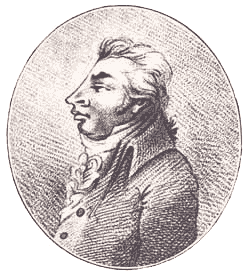Philip Adams, Sculptor
(fl. 1780-1810)
Sculptor
From A Dictionary of Irish Artists 1913

Philip Adams. Engraving in "Hibernian Magazine."
Was only son of Richard Adams, merchant, of Carlow. He entered the Dublin Society's drawing school on 5th May, 1774, and in 1779 was awarded a silver medal for practical geometry. He was also a pupil of Edward Smyth, the sculptor, and as such sent to the exhibition of the Society of Artists in William Street, in 1780, a bas-relief model of "Minerva conducting Genius to the Temple of Fame." He worked as a sculptor for some years in Townsend Street, chiefly as a carver of marble chimney-pieces.
The "Hibernian Journal" of January 4th, 1792, contains the following advertisement concerning a bust of the Prince of Wales: "Philip Adams, having lately visited London for the purpose of introducing this admirable model to the notice of the admirers of the fine arts in this kingdom and to the friends of His Royal Highness in particular, has now an opportunity of being the instrument of presenting to the nobility and gentry an excellent model of H.R.H. George Prince of Wales, which may be seen at 41 Townsend Street, where subscriptions for the bust are now being drawn. A few marble chimney-pieces to be sold." Adams was well known as a mimic and his company was sought as an entertaining and humorous companion. J. D. Herbert, in his. "Irish Varieties," refers to him as "a celebrated mimic and sculptor."
Relinquishing his profession as a sculptor he entered himself as a student in Gray's Inn on the 13th June, 1795, and was called to the English Bar on 13th May, 1801. In Michaelmas term, 1804, he was called to the Irish Bar. A notice of him in the "Hibernian Magazine" (April, 1811) says "his practice lay very much in the business of liberating insolvent debtors; . . . he was impelled to forward the deliverance of the unhappy debtor from motives of the noblest generosity and the purest spirit of humanity." He died in Mary Street in October, 1810, and was buried on the 28th at St. Mary's Church. The "Hibernian Magazine" (March, 1811) refers to him as a very singular and eccentric character who had raised himself "from a humble artisan to a barrister pleading before the Judges of the land." His portrait is in the "Hibernian Magazine" for March, 1811.
